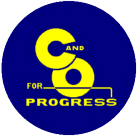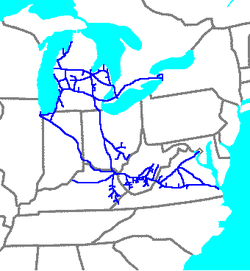The Chesapeake and Ohio Railway (reporting marks C&O, CO) was a Class I railroad formed in 1869 in Virginia from several smaller Virginia railroads begun in the 19th century. Led by industrialist Collis P. Huntington, it reached from Virginia's capital city of Richmond to the Ohio River by 1873, where the railroad town (and later city) of Huntington, West Virginia, was named for him.
 | |
 The C&O system map in 1950 | |
| Overview | |
|---|---|
| Headquarters | Cleveland, Ohio |
| Reporting mark | C&O, CO |
| Locale | District of Columbia, Illinois, Indiana, Kentucky, Michigan, New York, Ohio, Ontario, Pennsylvania, Virginia, West Virginia and Wisconsin |
| Dates of operation | 1868–1987 |
| Predecessor | Louisa Railroad |
| Successor | CSX |
| Technical | |
| Track gauge | 4 ft 8+1⁄2 in (1,435 mm) standard gauge |
Tapping the coal reserves of West Virginia, the C&O's Peninsula Extension to new coal piers on the harbor of Hampton Roads resulted in the creation of the new City of Newport News. Coal revenues also led the forging of a rail link to the Midwest, eventually reaching Columbus, Cincinnati and Toledo in Ohio and Chicago, Illinois.
By the early 1960s the C&O was headquartered in Cleveland, Ohio. In 1972, under the leadership of Cyrus Eaton, it became part of the Chessie System, along with the Baltimore and Ohio and Western Maryland Railway. The Chessie System was later combined with the Seaboard Coast Line and Louisville and Nashville, both the primary components of the Family Lines System, to become a key portion of CSX Transportation (CSXT) in the 1980s.[1]
C&O's passenger services ended in 1971 with the formation of Amtrak. Today Amtrak's tri-weekly Cardinal passenger train follows the historic and scenic route of the C&O through the New River Gorge in one of the more rugged sections of West Virginia. The rails of the former C&O also continue to transport intermodal and freight traffic, as well as West Virginia bituminous coal east to Hampton Roads and west to the Great Lakes as part of CSXT, a Fortune 500 company which was one of seven Class I railroads operating in North America at the beginning of the 21st century.
At the end of 1970 C&O operated 5,067 mi (8,155 km) of road on 10,219 mi (16,446 km) of track, not including WM or B&O and its subsidiaries.
Passenger Operations and the "Chessie" Cat mascot
editThe Chesapeake and Ohio Railway never spent lavishly on streamlined passenger trains, or passenger service in general, opting to put most of its resources into moving coal and freight. However, it did have a number of well known passenger trains including the George Washington, Fast Flying Virginian, Sportsman, Pere Marquette, and Resort Special.[citation needed] While the George Washington was the railroad's flagship, the Sportsman (which connected Detroit with Washington, D.C., and Newport News) and the Resort Special were also well-traveled trains on the system. Much of the reason for the popularity of C&O's passenger trains was because of Chessie, the sleeping kitten, one of the most successful and fondly remembered marketing campaigns ever developed. Chessie was so popular when she debuted in 1933 that the C&O could not keep enough merchandise in stock.[citation needed]
The C&O mostly focused on passenger trains in the eastern half of its system. Despite connecting to Chicago, the largest rail hub and third largest city in the country, passenger service to it was discontinued in 1933. Trains continued to run as west as Hammond, Indiana, a Chicago suburb, until 1949.[2] It had accessed the city’s Central Station (and previously, Dearborn Station) via the former Chicago, Cincinnati and Louisville Line.
Chessie sported two kittens, Nip and Tuck. During World War II, Chessie's "husband" — Peake — (creating the name "Chessie Peak", as in Chesapeake) was shown with a bandage on his paw as a war veteran returning from military service.
While the kitten was created by the Austrian artist Guido Grünewald, the success of Chessie as a marketing tool is often credited to Lionel Probert, at the time an assistant to the C&O president.[citation needed]
Chessie System, CSX
editC&O continued to be one of the more profitable and financially sound railways in the United States, and in 1963, under the guidance of Cyrus S. Eaton, helped start the modern merger era by "affiliating" with the Baltimore & Ohio. The two lines' services, personnel, motive power and rolling stock, and facilities were gradually integrated. Under the leadership of Hays T. Watkins, in 1973 Chessie System was created as a holding company for the C&O, B&O and Western Maryland Railway. In effect, C&O formally adopted a nickname that had been used colloquially for the railroad for several years, after the mascot kitten used in ads since 1933.
Under Watkins' leadership, Chessie System then merged with Seaboard Coast Line Industries, holding company for Seaboard Coast Line Railroad and several other great railroads of the Southeast (including Louisville and Nashville Railroad, Clinchfield Railroad and others) to form CSX Corporation, with Chessie and SCL as its leading subsidiaries. Watkins became CEO of the merged company.
Over the next five years, the CSX railroads began consolidating into one mega-railroad. The process began when SCL merged its railroads into the Seaboard System Railroad in 1982.
Western Maryland was merged into B&O on May 1, 1983. B&O was merged into C&O on April 30, 1987. Seaboard changed its name to CSX Transportation on July 1, 1986. Finally, C&O merged into CSX Transportation on Aug. 31, 1987. After acquiring 42% of Conrail in 1999, CSX became one of four major railroad systems left in the country.
See also
edit- C&O desk, donated to the White House
- List of Chesapeake and Ohio locomotives
- George Washington, the C&O's premier passenger train from 1932 to 1971
- Charles T. Hinde, Successful businessman and riverboat captain.
- Greenbrier River Trail
References
edit- ^ Surface Transportation Board, Docket AB_55_627_X Archived 2007-03-21 at the Wayback Machine, CSX Transportation, Inc.--abandonment exemption—in Floyd County, KY, February 14, 2003
- ^ [1] Chesapeake and Ohio Railway
Further reading
edit- Dixon, Thomas W. Jr. (2011). Volume 2: Chesapeake & Ohio. Virginia Railroads (1st ed.). TLC Publishing. ISBN 978-0939487516.